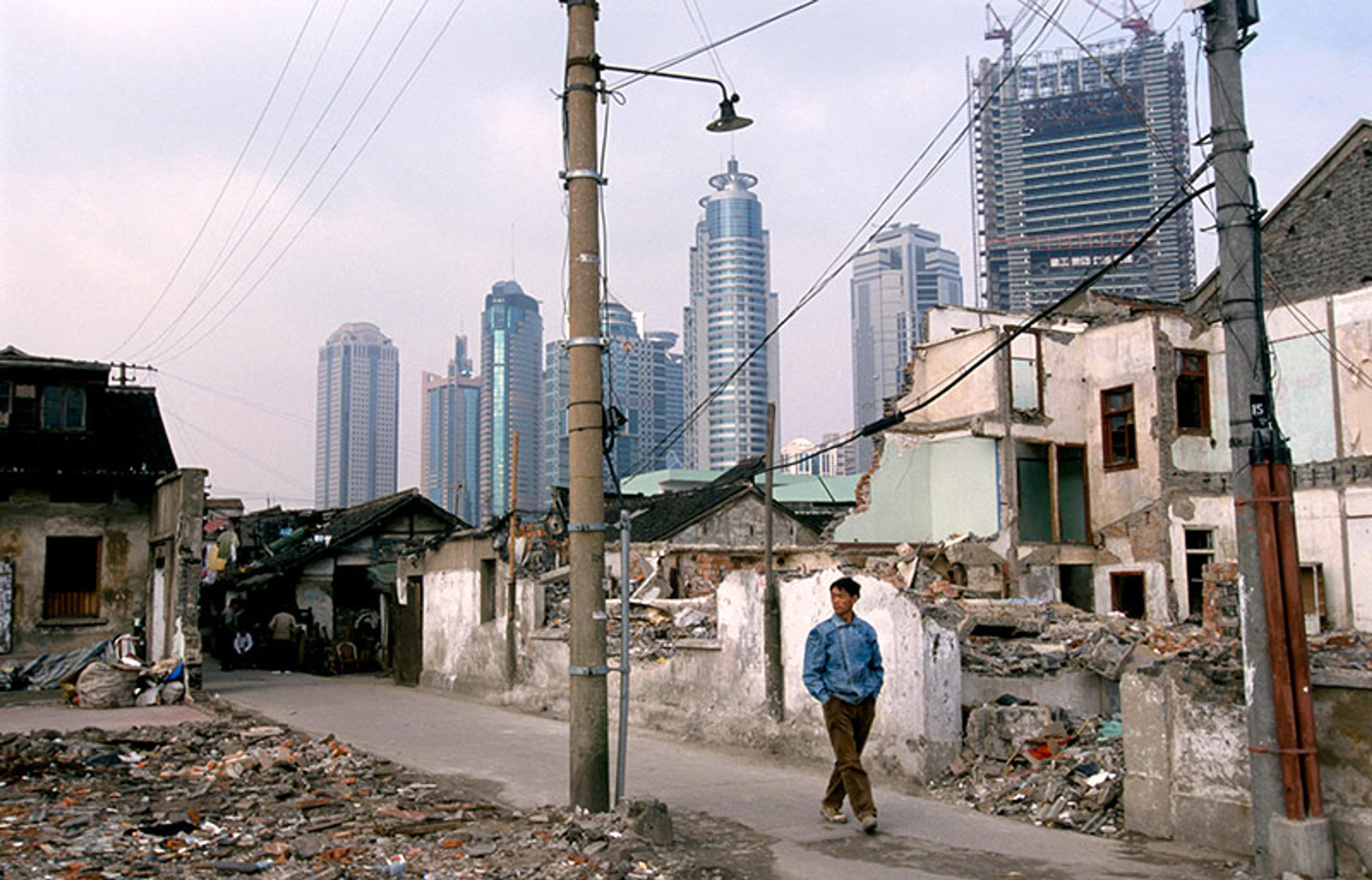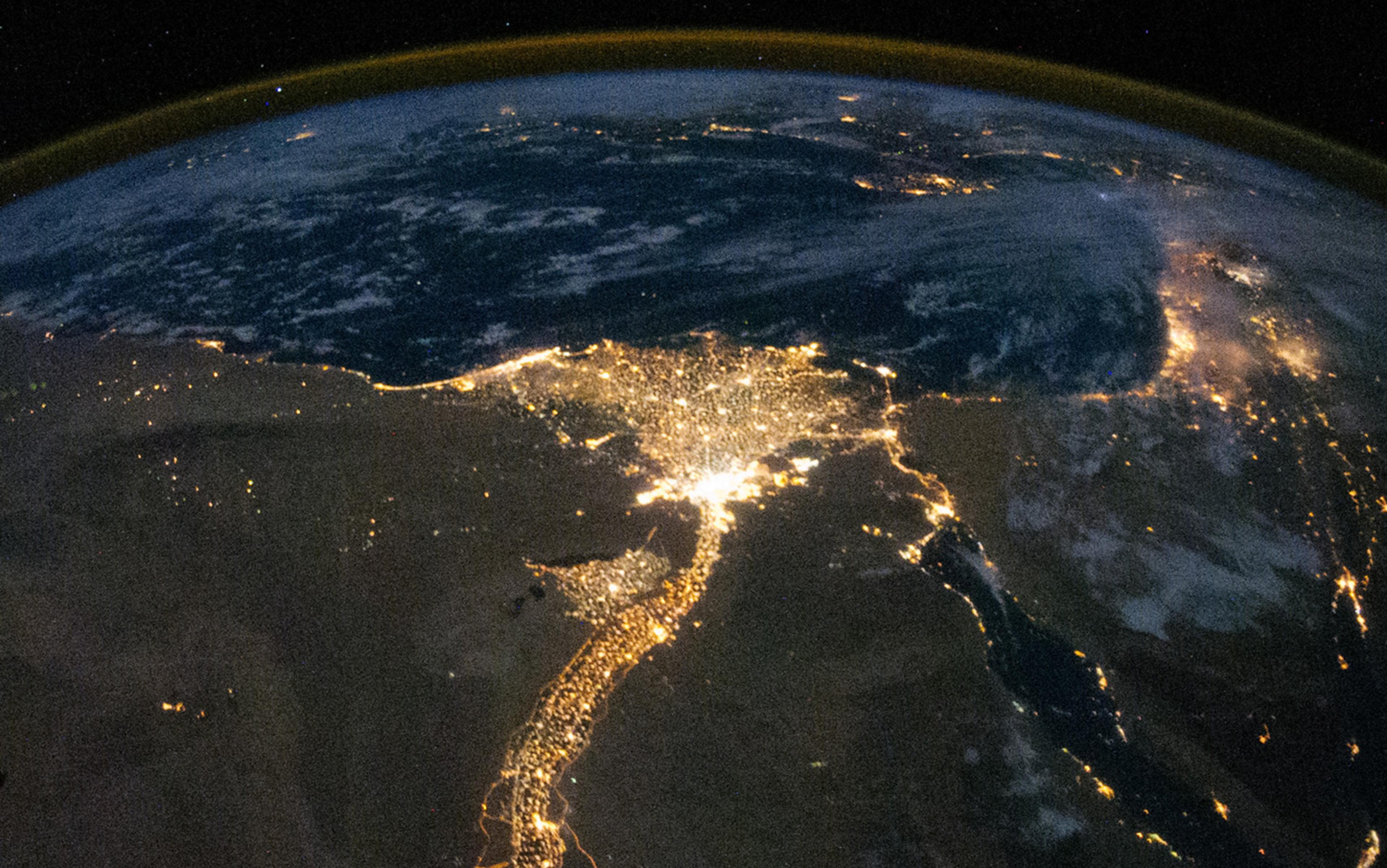In 1996, one in three inhabitants of China lived in an urban setting. In 2021, the figure was close to two in three. In the United States, in comparison, the figure is four in five. The construction boom in China tracks a moment of transition of geological significance in Earth’s history: humans are now a modally urban species. Sometime less than 15 years ago, the population of urban areas surpassed that of rural areas for the first time in history, and trends in the size of Earth’s cities show accelerating growth over the past 200 years. Approximately 250 years ago, there were three cities on Earth with more than a million human inhabitants: Edo (present-day Tokyo), Beijing and London. Today the figure is around 550.
Though it receives less attention than the climate crisis, food security, energy consumption, demand for industrial commodities, biodiversity loss or ageing populations, urbanisation is implicated in all of these. It is among the exemplary phenomena of a wide-ranging crisis of intensification – the growing risk, you might say, that humanity will default on its carbon debt – whose scope we are just starting to appreciate. As we’ll see, perhaps more than any other component of the intensification crisis, urbanisation is tied to the question of what it means to lead a good life, not to say to the rubrics of value that govern our economic behaviour.
Imagine the human clade endures another 10,000 years on Earth, at length summoning the will to conduct an inquest into What Went Wrong in that period – our present and near future – that the novelist William Gibson has evocatively termed ‘the Jackpot’. Among the things these future archaeologists would observe is that, in the generations leading up to our present, humans piled into cities like there was no tomorrow. What would they make of this?
The interpretive challenge is twofold. First, from a distance of 10,000 years, the appeal of urban living would be far from obvious. Second, social scientists’ habits of reasoning about the dynamics of intensification often obscure more than they reveal. As we’ll see, these two phenomena go together. Our epistemic framework for reasoning about urbanisation has been shaped by a need to make it seem, after the fact, desirable if not inevitable.
By treating the two dimensions, the material and the ideological, in tandem, we can open up a space in which to imagine ways of living that, at present, remain inaccessible. We begin with an obstinate fact: cities are engines of debility.
Cities are hard on the body. We are all familiar now with how dense living facilitates the spread of airborne disease. But the stressors of urban life are manifold. They include air- and waterborne pollution, noise, heat, light – and an excess of social contact. Pollution represents, as a 2017 report by the Lancet Commission on pollution and health puts it, ‘the largest environmental cause of disease and premature death’ among humans, responsible, in 2015, for ‘three times more deaths than from AIDS, tuberculosis, and malaria combined and 15 times more than from all wars and other forms of violence’ – and the burden will grow as wildfire becomes a year-round phenomenon. Pollution is neurotoxic, mutagenic and endocrine disrupting, to say nothing of its effects on breathing, vision, smell and touch.
Like factory farms and oil refineries, cities rely on surrounding areas to serve as pollution sinks. But, in most places, it is city dwellers themselves – and above all residents of low-income communities – who bear the brunt of the burden.
Then there is noise. Exposure to sound-pressure levels in excess of 90 decibels – common in restaurants – causes mechanical trauma to the hair cells of the basilar membrane. Even exposure at pressure levels long considered mechanically safe can, over time, yield irreversible changes in audition.
And the effects of noise extend beyond the auditory. Across a broad range of animal taxa, including mammals, chronic acoustic stress has been found to negatively affect reproduction, childhood development, metabolism, cardiovascular health, sleep, cognition and immune function.
Perhaps the most surprising risk of urban living is schizophrenia. The effect even exhibits a dose response: the more time you spend in cities, the greater your risk. The precipitating stressor appears to be at least partly social in nature, with the disenfranchised at highest risk. A mediating role has been hypothesised for danger-associated molecular patterns, signalling cascades that evoke inflammation in the absence of tissue trauma, as if in anticipation of injury. Spending time in green spaces lowers the risk.
We are drawn to cities by pressing needs. The downsides unfold over longer horizons
Cities are good for many things, but minimising debility is not among them. And yet, we’re crazy about them. Why?
A comparison will help. Consider agriculture.
As with urban living, from a distance of 10,000 years, the appeal of agriculture is far from obvious. Cultivation and herding required more labour than gathering and hunting, and that labour had to be coordinated in ways that demanded a new kind of corporatism and deference to authority. The products of agriculture, in turn, became bound, in imagination and then in law, to the particular episodes of labour that had yielded them. This encouraged the hoarding of surpluses, undermining mutual assistance and fostering inequality.
On top of all this, the diets of early food producers were less abundant in trace nutrients than those of coeval foragers and less secure in energetic terms. By adopting a diet that was less diverse, in its constituents and in the knowledge needed to acquire them, food producers put themselves at risk of a shortfall.
Agriculture was not everywhere subject to runaway feedback. We have evidence of long-term stable economies at many levels of reliance on raised foods short of total commitment. But across Eurasia and Africa and large parts of the Americas and the Pacific, we do observe a transition to agriculture. So it had something going for it.
Of course, Neolithic peoples did not decide to domesticate plants and animals. Agriculture unfolded in a mesh of gestures guided by immediate concerns – declining prey populations, a dawning realisation that it might be possible to make the rice come to the settlement rather than the other way around. Opposing signals – the realisation that it takes more work to produce rice than to harvest it in the wild, chronic anaemia in children, entrenched inequality – appeared later. As a consequence, the selection pressure these negative effects exerted on behaviour was weaker.
In similar fashion, we are drawn to cities by pressing needs – for work, for stimulation, to be someplace where we don’t already know everyone in the pool of potential mates, to give our kids access to greater educational opportunities – or simply to escape the genial surveillance of village life. The downsides – infection, floods, heat islands, air pollution, the social stress, the constant light and noise, the dearth of quiet green spaces, the want of space to grow your own food at a pinch – unfold over longer horizons.
In the case of agriculture, over time, ideologies arose to justify the new reality – deference to big men, human mastery over the land, labour equals property. Is something similar happening with cities?
In a widely cited paper from 2007, the physicist Luís Bettencourt and colleagues demonstrated that, on a number of common measures of innovation and wealth creation, cities deliver benefits that exceed what we would expect by a simple scaling up of the numbers of people involved, and at lower cost in terms of the infrastructure required. That is, the power laws relating city size (by population) to, say, number of patents issued in a given time period have exponents greater than 1, whereas those relating population to the quantities of copper, asphalt and thermoplastic piping required to provide inhabitants with electricity, transport and running water have exponents less than 1. Cities deliver economies of scale.
The paper ‘Growth, Innovation, Scaling, and the Pace of Life in Cities’ by Bettencourt and colleagues appeared amid a wave of interest, among theorists of social complexity, in modelling innovation as a function of population. In anthropology, this took the form of speculation that technical culture unfolds – unrolls? – on a demographic treadmill. The transmission of knowledge from one generation to the next is prone to error. To ensure the maintenance, let alone growth, of technical culture over time, you need a sufficient cadre of knowledgeable individuals to serve as models for new learners. In the treadmill metaphor, the speed of the treadmill is the rate of error accumulation; the speed of the runner, the population of the community. In isolation, a community risks falling off the treadmill, losing both existing technology and the capacity to innovate anew.
We are unable to imagine an economic system founded on something other than insatiability
Treadmill models are seductive in their simplicity, but they evince the same bias toward growth that has long afflicted economics. Lately growth-centrism has come in for reappraisal under the sign of degrowth or steady-state economics.
Not long ago, the economist Branko Milanović, a careful observer of the relationship between growth and inequality, published a critique of degrowth. Milanović stresses the role that growth has played in alleviating inequality. It is difficult to achieve redistribution in the absence of growth, since incumbents tend to view their assets, even those gained by accidents of life history, as things they are entitled to. Growing the pie is less conflict-prone than asking people to share. But Milanović adds that proponents of the view that growth is ‘incidental’ (that is, not an essential feature of economic life)
should start by trying to change the bases on which our (global capitalist) civilisation has been built, namely insatiability of needs and commodification. But these features have become so strongly ingrained that I cannot see how they can be changed in any foreseeable future.
That is: the problem is one not of physics or politics, but of vision. We are unable to imagine a system of economic arrangements founded on something other than insatiability.
How do we step off the growth treadmill before we get pulled under? Can we imagine what a steady-state world would be like, imagine the actual living arrangements – houses, relationships, meals? Bettencourt and colleagues’ analysis suggests that one of the things that has selected for accelerating urbanisation is that large cities are more efficient at delivering economic growth. So perhaps an equilibrium world could not be an urban one. But before we get ahead of ourselves, let’s pause to consider what it is about urbanisation that creates economies of scale. Is it simply the intellectual ferment that comes of proximity to so many of one’s conspecifics? I’d like to propose two additional factors. First, urbanisation is an extractive phenomenon. Second, urban economies of scale are partly an artefact of how we delimit the object of enquiry – how we draw the line between city and not-city. These two phenomena work together. To see how, let’s consider the spatial dynamics of urbanisation.
Newly emerging cities today bear scant resemblance to the compact metropoles of mid-20th-century science fiction. Urban growth is characterised by a dendritic quality, with higher-density areas – growth nuclei – linked together by transport networks surrounded by agricultural land and low-density settlement. If you have travelled in parts of the world that are urbanising rapidly, you will have observed how roads become scaffolds for ribbon cities, linear settlements that grow up to serve the needs of the road. In some places, a six-hour journey can feel like an extended tour of tea stalls and auto-repair shops, in which you never leave urban space en route from one city to another – even if, were you to pull over and cut across the ribbon of settlement, you would rapidly find yourself in someone’s fields. (In the US, an absence of public policy to limit sprawl has meant that the ribbon quality persists, save that today the exemplary built form of the ribbon is the big-box store.)
In many parts of the world, urban growth has been driven by informal – or, if you prefer, autonomous – construction, by and large undertaken by migrants from the countryside, with new neighbourhoods struggling for recognition from the municipal government, and the extension of amenities such as running water and sewerage. This has been the pattern in many parts of Latin America, Africa and South Asia. In other places, growth has been driven by the state. In China, competition between provinces to build ‘Tier 1’ cities has left large parts of the interior dotted with ‘ghost cities’, high-density residential districts with vacancy rates of up to 90 per cent. The deeply indebted Chinese property developer Evergrande and its congeners have benefitted from a regulatory environment formulated to encourage urbanisation, selling not-yet-built apartments on spec, pulling in capital from state-backed lenders and enthusiastic investors, and using advance revenue from new projects to pay suppliers from the last round. But, even in China, migrant-led growth has played a role, with autonomous expansion into the agricultural fringe leaving municipal governments struggling to impose order.
We’d do well to regard those roadside emoliente stalls not as sprawl, but as social solidarity in action
Take Pudong, a rapidly urbanising district outside Shanghai. Thirty years ago, Pudong was farmland. Today, parts of it are on their second or third wave of development, with Nike stores sprouting from the ruins of shopping malls. In 2018, when I was revising a book on meat-eating, I spent three months there testing it on students at one of China’s first experiments in liberal education. They were unimpressed, and I spent a lot of time walking the neighbourhood, rewriting in my head. By luck, not five minutes from my home stood an open-air wet market, one of the last of its kind in Shanghai. I took to spending time there every day.
One day, toward the end of my time in Pudong, I took a shortcut through the market. It was four in the afternoon. Ordinarily, the market would be packed with pedestrians and motorbikes. Instead, it was quiet, stalls shuttered, vendors squatting out front. I got halfway down only to find police cordoning off the main laneway. On the far side of the police tape, a man was at work with a plasma torch, taking apart the entrance to a stall. Apparently, the city had been trying to close it for years. But a few months later, I learned the market had simply shifted south, spilling out onto the undeveloped lots that bordered the arterial road.

We’ve seen two kinds of urbanisation, capital-driven and autonomous. Our capital-oriented habits of reasoning tend to obscure the dynamics of autonomous urbanisation. Between 1992 and 2004, with support from the World Bank and a network of foundations committed to promoting economic liberalisation in the developing world, the government of Peru conducted an experiment in granting title to the residents of autonomously settled neighbourhoods in Peru’s cities. The sponsors’ hypothesis was that regularising title would enhance residents’ access to capital, thus lifting them out of poverty. This did not happen. What did happen was that residents of neighbourhoods eligible for the programme, who received title to their homes, started working more, in particular outside the home. The authors of a World Bank study of the programme concluded – with no evidence – that this meant that, with title, residents no longer felt the need to stay at home to defend their property. As the historian Timothy Mitchell has shown, a more plausible explanation stems from the fact that neighbourhoods were selected for the programme on the basis of ease of entry: older, more established neighbourhoods in more secure places went first. By the conclusion of the study period, one-third of eligible households not yet offered title were in the Quechua-majority highlands town of Huancayo, the area hardest hit by the civil war of the 1980s.
‘Typically,’ Mitchell notes, ‘a squatter neighbourhood was formed by a single village, whose members would plan their relocation collectively in advance … and reproduce the communal associations of the village in the new location.’ We’d do well to regard those roadside emoliente stalls not as sprawl, but as social solidarity in action. The titling programme, the World Bank study acknowledged, weakened these associations. Nonetheless, the programme was held up as a demonstration of the power of liberalisation to promote development.
The dendritic character of urbanisation is nothing new. When you walk through London, you can read the history of multinucleate expansion in the change in character at the boundaries between adjoining districts – these are the points where distinct villages grew until they fused. But today, the dendritic pattern is more salient, in part because urbanisation is unfolding faster than in the past, and in part because satellite imaging and other technologies of remote sensing afford us a synoptic, if sometimes misleading, view of Earth’s surface.
Characterising the spatial dimensionality of urbanisation – the degree to which cities, as they grow, diverge in shape from the perimeter-minimising convex polygons you encountered in elementary geometry – is an area of active research. But you do not need a precise estimate of dimensionality to observe, just looking at satellite images of night-time illumination in densely settled parts of Earth, that the edges of large conurbations bear comparison to coastlines – they have a certain fractal or self-similar quality. Involutions, divergences from convexity, give rise to new series of such divergences at a more localised scale. Dendrites ramify, their branch points often growing into new nuclei, new centres of radiation.
Satellite remote imaging dates to 1959. Today, remote imaging is served by a broad array of state-sponsored and commercial satellite programmes, including low-cost CubeSats, which trade higher resolution for increased coverage. Still, as the geographer Noam Levin and colleagues explain in a recent review, ‘it is not straightforward to find a single optimal threshold that can accurately delineate both large cities and small cities simultaneously’ – either you capture the large cities but lose the smaller ones, or you capture the towns but overestimate large cities. The thresholding problem is complicated by variation in standards for urban lighting, and the recent shift from sodium vapour to LED-based lighting has introduced new challenges. Nonetheless, satellite imaging of night-time illumination has found a host of applications, including the estimation of GDP, the mapping of meteorological disasters, the monitoring of armed conflicts – and, to return to where we started, the estimation of epidemiological risk: the disruption to animal circadian rhythms caused by artificial night-time lighting has been implicated in cancer, obesity and depression, among other forms of debility. (The US National Oceanic and Atmospheric Administration has made available a series of composite visualisations of change in night-time illumination between 1992 and 2012. See, for example, 2010.)
One thing that remote sensing has made clear is the extent to which cities draw on resources at a regional scale – fresh water, clean air, agricultural productivity – without experiencing short-term negative feedback. For a while, rapidly growing cities can externalise the costs of growth – and thus exhibit economies of scale, when the demands on the broader region are left off the balance sheet. The dendritic quality of urban growth goes some way to explaining how this could happen. Cities do not bloom across the surface of Earth like dandelions across a field. Rather, they spread like mycelia, maximising their contact surface with their milieu and, by extension, maximising opportunities to pull in resources from less densely populated – and often, less politically influential – parts.
Nowhere is this pattern clearer than with food. Cities consume one to two orders of magnitude more food energy than other kinds of inhabited space – but they tend to play a limited role in producing this energy.
A society where everyone kept a hand in the basic work of getting a living from the Sun would be more resilient
What if we put food autonomy at the centre of urban design? In fact, what if we learned to see cities as vegetative surfaces with hyphae of structure embedded in them, rather than the reverse?
These vegetative surfaces could not be gardens or farms, nor could they be like greenhouses or precision vertical farms. The strategy underlying all of these is one of simplification in the service of scale: you select the things you want to grow, then you create a biome consisting of just those things. But recent events suggest we have exceeded the limits of marginal return to scale.
The pattern I have in mind would privilege not scale, but topological complexity. It would depend on a supple grasp of the allelopathic interactions that are essential to how living things organise themselves in ensembles – the chemical signalling pathways by which plants and their fungal and microbial symbiotes coordinate interests to allow a range of taxa to flourish in concert. The work of fashioning such a biome would bear comparison to that undertaken by the first human colonists of Australia, who used fire to create a landscape conducive to foraging – more nudging than cultivating. But it would have a vertical element. Tending these – what to call them? hanging forests? – would be a basic feature of urban life and not the remit of invisible low-wage specialists. A society where everyone was obliged to keep a hand in the basic work of getting a living from the Sun would be more resilient – you’d never want for models of the most essential forms of skill. And no one would be denied access to green spaces.
To imagine a world where humanity looks back on our present from a vantage of security is to imagine a world where we privilege the complexity of taxonomically diverse biotic ensembles over the simplification-at-scale of agriculture as it is today. Above all, this would be a world where we grasped, to riff on the anthropologist Marshall Sahlins, that while the mind may be insatiable, the needs of the body are easily met.
Perhaps this is beyond us. But let’s return now to the thought experiment I posed at the top. Imagine this time not an inquest, but something more open-ended – a symposium, 10,000 years from now. The theme is ‘Urbanisation: Pathways Through and Beyond’. It is break time. Participants stretch, make light conversation, look out at the forest below. The day has run long, owing to a lively methodological discussion following the presentation on the use of single-photon gamma scintillation tomography, which has enabled the nondestructive imaging of archaeological debris sequences to a depth of 100 metres – down through the Dust Horizons of 9,900-3,000 years ago. The findings are sobering: the sheer number of close calls. If history be a guide, you’re about a thousand years out from the next. Any one of them could be the last.
But tonight the forest is at peace. Stepping out on the platform, you hear, from far below, the cries of screaming pihas and the grunting of peccaries. The air is pungent with the scent of high-canopy histosols – the humus that forms on the branches. The light has gone. And now it is time to gather dinner.






